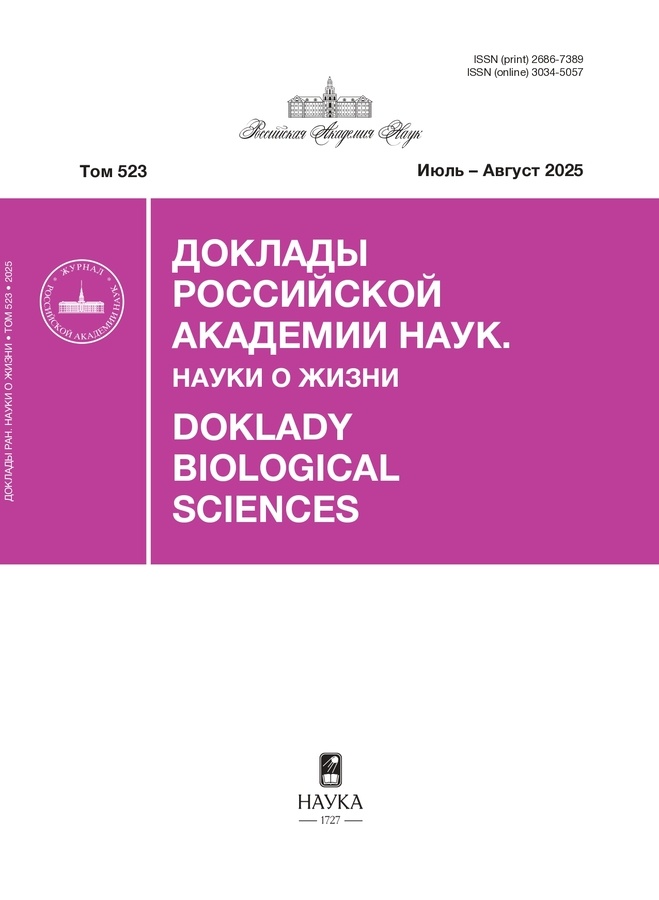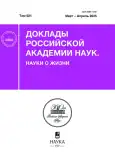Regenerative potential of platelet-rich plasma in diabetes mellitus
- Authors: Vlasova T.I.1, Brodovskaya E.P.1, Madonov К.S.1, Ageev V.P.1, Abelova A.P.1, Pinyaev S.I.1, Vlasov А.P.1
-
Affiliations:
- Federal State Budgetary Educational Institution of Higher Education “National Research Ogarev Mordovia State University”
- Issue: Vol 521, No 1 (2025)
- Pages: 268-279
- Section: Articles
- URL: https://vestnik.nvsu.ru/2686-7389/article/view/684072
- DOI: https://doi.org/10.31857/S2686738925020176
- ID: 684072
Cite item
Abstract
The study explores in vitro the regenerative potential of platelet-rich plasma (PRP) from patients with type 1 diabetes mellitus: in a series of experiments they add PRP to the culture medium of dermal fibroblasts and evaluate in dynamics the metabolic (including the production of reactive oxygen species), migration and proliferation activity of the cells, and they also determine the growth factors and exosomes levels in PRP and the medium. They reveal a decrease in the proliferative, prooxidant and toxic effects of PRP from patients with diabetes mellitus. They are characterized with a decrease in metabolic activity and cell viability in culture with an increase in the percentage of necrosis, while the migration properties of the cells were not impaired. The presence of diabetes mellitus in a patient is also accompanied by a decrease in the stimulating effect of his PRP on dermal fibroblasts in the secretion of growth factors. These effects were most significant in elderly people with diabetes.
Full Text
About the authors
T. I. Vlasova
Federal State Budgetary Educational Institution of Higher Education “National Research Ogarev Mordovia State University”
Author for correspondence.
Email: v.t.i@bk.ru
Russian Federation, Moscow
E. P. Brodovskaya
Federal State Budgetary Educational Institution of Higher Education “National Research Ogarev Mordovia State University”
Email: v.t.i@bk.ru
Russian Federation, Moscow
К. S. Madonov
Federal State Budgetary Educational Institution of Higher Education “National Research Ogarev Mordovia State University”
Email: v.t.i@bk.ru
Russian Federation, Moscow
V. P. Ageev
Federal State Budgetary Educational Institution of Higher Education “National Research Ogarev Mordovia State University”
Email: v.t.i@bk.ru
Russian Federation, Moscow
A. P. Abelova
Federal State Budgetary Educational Institution of Higher Education “National Research Ogarev Mordovia State University”
Email: v.t.i@bk.ru
Russian Federation, Moscow
S. I. Pinyaev
Federal State Budgetary Educational Institution of Higher Education “National Research Ogarev Mordovia State University”
Email: v.t.i@bk.ru
Russian Federation, Moscow
А. P. Vlasov
Federal State Budgetary Educational Institution of Higher Education “National Research Ogarev Mordovia State University”
Email: v.t.i@bk.ru
Russian Federation, Moscow
References
- Kastyro I.V., Khamidulin G.V., Dyachenko Yu.E., Kostyaeva M.G., Tsymbal A.A., Shilin S.S., Popadyuk V.I., Mikhalskaya P.V., Ganshin I.B. Analysis of p53 protein expression and formation of dark neurons in the hippocampus of rats during septoplasty modeling. // Russian Rhinology (2023) 31(1):27–36.
- Kostyaevaa M.G., Kastyro I.V., Yunusov T.Yu., Kolomin T.A., Torshin V.I., Popadyuk V.I., Dragunova S.G., Shilin S.S., Kleiman V.K., Slominsky P.A., Teplov A.Y. Protein p53 Expression and Dark Neurons in Rat Hippocampus after Experimental Septoplasty Simulation. // Molecular Genetics, Microbiology and Virology (2022) 37(1):1924.
- Sun H., Saeedi P., Karuranga S., Pinkepank M., Ogurtsova K., Duncan B.B., et al. IDF Diabetes Atlas: Global, regional and country-level diabetes prevalence estimates for 2021 and projections for 2045. Diabetes Res Clin Pract (2022) 183:109119.
- Bazarov D.V., Charchyan E.R., Grigorchuk A.Y., Povolotskay O.B., Nikoda V.V., Kabakov D.G., Titova I.V., Galyan T.N., Pryanikov P.D., Vyzhigin M.A. Bleeding from the brachiocephalic trunk in tracheal surgery: whether the patient has a chance? // Head and neck. Russian Journal (2021) 9(3):50–60.
- Vanyushin Yu.S., Elistratov D.E., Fedorov N.A. Comprehensive study of the adaptation process cardiorespiratory system. // Head and neck. Russian Journal (2022) 10(2, Suppl.1): 32–35.
- Qu W., Wang Z., Hunt C. The effectiveness and safety of platelet-rich plasma for chronic wounds: A systematic review and meta-analysis. // Mayo Clin Proc (2021) 96(9):2407–17.
- Spampinato S.F., Caruso G.I., De Pasquale R., Sortino M.A., Merlo S. The treatment of impaired wound healing in diabetes: looking among old drugs. // Pharm (Basel) (2020) 13.
- OuYang H., Tang Y., Yang F., Ren X., Yang J., Cao H., Yin Y. Platelet-rich plasma for the treatment of diabetic foot ulcer: a systematic review. // Front Endocrinol (Lausanne). 2023 Nov 18;14:1256081.
- Solovieva A.O., Sitnikova N.A., Nimaev V.V., Koroleva E.A., Manakhov A.M. PRP of T2DM Patient Immobilized on PCL Nanofibers Stimulate Endothelial Cells Proliferation // Int J. Mol Sci. 2023 May 5;24(9):8262.
- Everts P., Onishi K., Jayaram P., Lana J.F., Mautner K. Platelet-Rich Plasma: New Performance Understandings and Therapeutic Considerations in 2020 //Int J. Mol Sci. 2020;21(20):7794.
- Alves R., Grimalt R. A Review of Platelet-Rich Plasma: History, Biology, Mechanism of Action, and Classification. // Skin Appendage Disord. 2018;4(1):18–24.
- Suarez-Arnedo A., Torres Figueroa F., Clavijo C., Arbela´ez P., Cruz J.C., Muñoz-Camargo C. An image J plugin for the high throughput image analysis of in vitro scratch wound healing assays. // PLoS ONE (2020) 15(7): e0232565.
- Giraldo C.E., López C., Álvarez M.E., Samudio I.J., Prades M., Carmona J.U. Effects of the breed, sex and age on cellular content and growth factor release from equine pure-platelet rich plasma and pure-platelet rich gel. // BMC Vet Res. 2013;9:29.
- Wang J.H.-C. Can PRP effectively treat injured tendons? // Muscle Ligaments Tendons J. 2014;4:35–37.
- Baar M.P., Perdiguero E., Muñoz-Cánoves P., De Keizer P.L. Musculoskeletal senescence: A moving target ready to be eliminated. // Curr. Opin. Pharmacol. 2018;40:147–155.
- Ritschka B., Storer M., Mas A., Heinzmann F., Ortells M.C., Morton J.P., Sansom O.J., Zender L., Keyes W.M. The senescence-associated secretory phenotype induces cellular plasticity and tissue regeneration. // Genes Dev. 2017;31:172–183.
- Miroshnichenko S., Usynin I., Dudarev A., Nimaev V., Solovieva A. Apolipoprotein A-I supports MSCs survival under stress conditions // Int. J. Mol. Sci. 2020;21:4062.
- Al-Mrabeh A. β-Cell Dysfunction, Hepatic Lipid Metabolism, and Cardiovascular Health in Type 2 Diabetes: New Directions of Research and Novel Therapeutic Strategies. // Biomedicines. 2021;9:226.
- Wang J.H.-C., Nirmala X. Perspectives on Improving the Efficacy of PRP Treatment for Tendinopathy // J. Musculoskelet. Disord. Treat. 2016; 2.
- Ritschka B., Storer M., Mas A., Heinzmann F., Ortells M.C., Morton J.P., Sansom O.J., Zender L., Keyes W.M. The senescence-associated secretory phenotype induces cellular plasticity and tissue regeneration. // Genes Dev. 2017;31:172–183.
- Nguyen P.A., Pham T.A.V. Effects of platelet-rich plasma on human gingival fibroblast proliferation and migration in vitro // J. Appl. Oral Sci. 2018;26.
- Vahabi S., Yadegari Z., Mohammad-Rahimi H. Comparison of the effect of activated or non-activated PRP in various concentrations on osteoblast and fibroblast cell line proliferation. // Cell Tissue Bank. 2017;18:347–353.
- Panda A., Arjona A., Sapey E., Bai F., Fikrig E., Montgomery R.R., Lord J.M., Shaw A.C. Human innate immunosenescence: Causes and consequences for immunity in old age. // Trends Immunol. 2009;30:325–333.
- Marushima A., Nieminen M., Kremenetskaia I., Gianni-Barrera R., Woitzik J., von Degenfeld G., Banfi A., Vajkoczy P., Hecht N. Balanced single-vector co-delivery of VEGF/PDGF-BB improves functional collateralization in chronic cerebral ischemia // J. Cereb. Blood Flow Metab. 2020;40:404–419.
- Gianino E., Miller C., Gilmore J. Smart Wound Dressings for Diabetic Chronic Wounds. // Bioengineering (Basel). 2018 Jun 26;5(3):51.
- Altalhi R., Pechlivani N., Ajjan R.A. PAI-1 in Diabetes: Pathophysiology and Role as a Therapeutic Target // Int J Mol Sci. 2021 Mar 20;22(6):3170.
- Qin Y., Zhang J., Babapoor-Farrokhran S., Applewhite B., Deshpande M., Megarity H., Flores-Bellver M., Aparicio-Domingo S., Ma T. Rui Y., Tzeng S.Y., Green J.J., Canto-Soler M.V., Montaner S., Sodhi A. PAI-1 is a vascular cell-specific HIF-2-dependent angiogenic factor that promotes retinal neovascularization in diabetic patients. // Sci Adv. 2022 Mar 4;8(9):eabm1896.
- Torreggiani E., Perut F., Roncuzzi L., Zini N., Baglio S.R., Baldini N. Exosomes: novel effectors of human platelet lysate activity. // Eur Cell Mater. 2014;28:137–51.
- Guo S.C., Tao S.C., Yin W.J., Qi X., Yuan T., Zhang C.Q. Exosomes derived from platelet-rich plasma promote the re-epithelization of chronic cutaneous wounds via activation of YAP in a diabetic rat model. // Theranostics. 2017 Jan 1;7(1):81–96.
- Zhang Y., Yi D. Hong Q., Cao J., Geng X., Liu J, Xu C., Cao M., Chen C. Xu S., Zhang Z., Li M., Zhu Y., Peng N. Platelet-rich plasma-derived exosomes boost mesenchymal stem cells to promote peripheral nerve regeneration // J Control Release. 2024 Mar;367:265–282.
Supplementary files

Note
Presented by Academician of the RAS I.V. Reshetov













